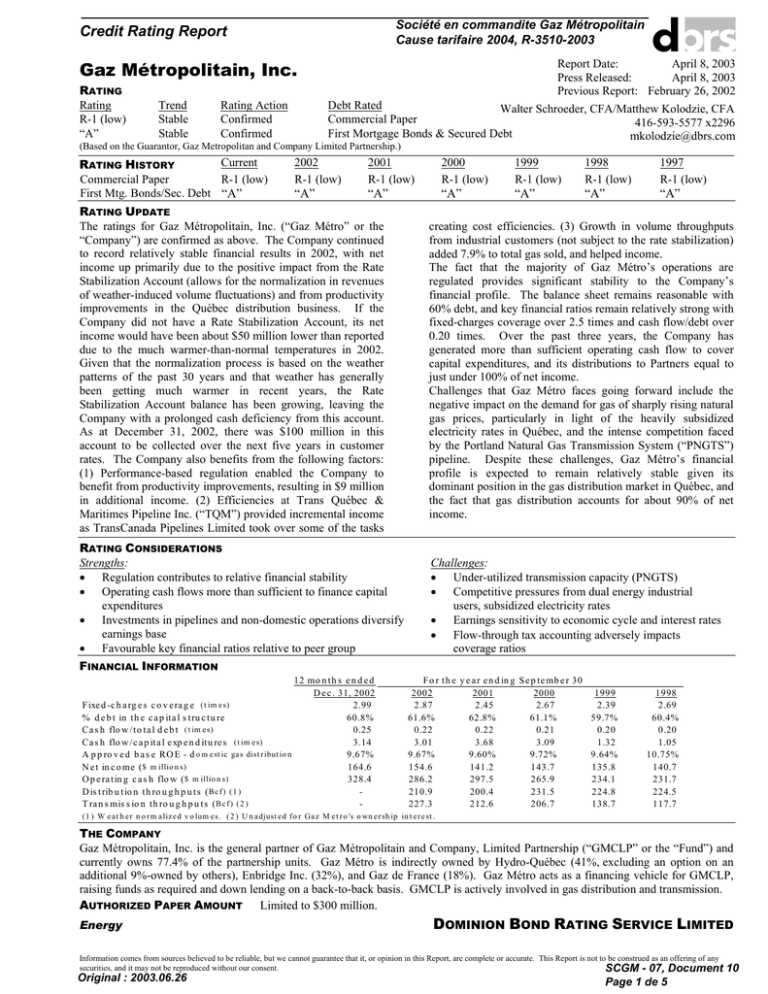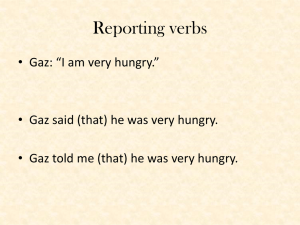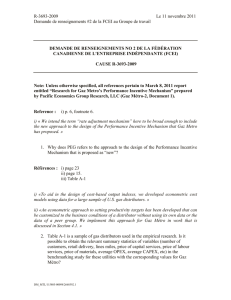Gaz Métropolitain, Inc. Credit Rating Report
advertisement

Société en commandite Gaz Métropolitain Cause tarifaire 2004, R-3510-2003 Credit Rating Report Gaz Métropolitain, Inc. RATING Rating R-1 (low) “A” Trend Stable Stable Rating Action Confirmed Confirmed Report Date: April 8, 2003 Press Released: April 8, 2003 Previous Report: February 26, 2002 Debt Rated Walter Schroeder, CFA/Matthew Kolodzie, CFA Commercial Paper 416-593-5577 x2296 First Mortgage Bonds & Secured Debt mkolodzie@dbrs.com (Based on the Guarantor, Gaz Metropolitan and Company Limited Partnership.) Current RATING HISTORY Commercial Paper R-1 (low) First Mtg. Bonds/Sec. Debt “A” 2002 R-1 (low) 2001 R-1 (low) 2000 R-1 (low) 1999 R-1 (low) 1998 R-1 (low) 1997 R-1 (low) “A” “A” “A” “A” “A” “A” RATING UPDATE The ratings for Gaz Métropolitain, Inc. (“Gaz Métro” or the “Company”) are confirmed as above. The Company continued to record relatively stable financial results in 2002, with net income up primarily due to the positive impact from the Rate Stabilization Account (allows for the normalization in revenues of weather-induced volume fluctuations) and from productivity improvements in the Québec distribution business. If the Company did not have a Rate Stabilization Account, its net income would have been about $50 million lower than reported due to the much warmer-than-normal temperatures in 2002. Given that the normalization process is based on the weather patterns of the past 30 years and that weather has generally been getting much warmer in recent years, the Rate Stabilization Account balance has been growing, leaving the Company with a prolonged cash deficiency from this account. As at December 31, 2002, there was $100 million in this account to be collected over the next five years in customer rates. The Company also benefits from the following factors: (1) Performance-based regulation enabled the Company to benefit from productivity improvements, resulting in $9 million in additional income. (2) Efficiencies at Trans Québec & Maritimes Pipeline Inc. (“TQM”) provided incremental income as TransCanada Pipelines Limited took over some of the tasks creating cost efficiencies. (3) Growth in volume throughputs from industrial customers (not subject to the rate stabilization) added 7.9% to total gas sold, and helped income. The fact that the majority of Gaz Métro’s operations are regulated provides significant stability to the Company’s financial profile. The balance sheet remains reasonable with 60% debt, and key financial ratios remain relatively strong with fixed-charges coverage over 2.5 times and cash flow/debt over 0.20 times. Over the past three years, the Company has generated more than sufficient operating cash flow to cover capital expenditures, and its distributions to Partners equal to just under 100% of net income. Challenges that Gaz Métro faces going forward include the negative impact on the demand for gas of sharply rising natural gas prices, particularly in light of the heavily subsidized electricity rates in Québec, and the intense competition faced by the Portland Natural Gas Transmission System (“PNGTS”) pipeline. Despite these challenges, Gaz Métro’s financial profile is expected to remain relatively stable given its dominant position in the gas distribution market in Québec, and the fact that gas distribution accounts for about 90% of net income. RATING CONSIDERATIONS Strengths: • Regulation contributes to relative financial stability • Operating cash flows more than sufficient to finance capital expenditures • Investments in pipelines and non-domestic operations diversify earnings base • Favourable key financial ratios relative to peer group FINANCIAL INFORMATION Challenges: • Under-utilized transmission capacity (PNGTS) • Competitive pressures from dual energy industrial users, subsidized electricity rates • Earnings sensitivity to economic cycle and interest rates • Flow-through tax accounting adversely impacts coverage ratios 12 mo n t h s e n d e d D e c . 31, 2002 F ixe d -c h a rg e s c o v e ra g e ( t im e s) 2.99 % d e b t in t h e c a p ita l s t ru c t u re 60.8% Ca s h flo w / t o t a l d e b t ( t im e s) 0.25 Ca s h flo w / c a p it a l e xp e n d it u re s ( t im e s) 3.14 A p p ro v e d b a s e RO E - d o m e st ic ga s dist r ibut io n 9.67% N e t in c o me ( $ m illio n s) 164.6 O p e ra t in g c a s h flo w ( $ m illio n s) 328.4 D is t rib u t io n t h ro u g h p u t s ( B c f ) ( 1 ) T ra n s mis s io n th ro u g h p u ts ( B c f ) ( 2 ) - F o r t h e y e a r e n d in g S e p te mb e r 30 2002 2001 2000 1999 2.87 2.45 2.67 2.39 61.6% 62.8% 61.1% 59.7% 0.22 0.22 0.21 0.20 3.01 3.68 3.09 1.32 9.67% 9.60% 9.72% 9.64% 154.6 141.2 143.7 135.8 286.2 297.5 265.9 234.1 210.9 200.4 231.5 224.8 227.3 212.6 206.7 138.7 1998 2.69 60.4% 0.20 1.05 10.75% 140.7 231.7 224.5 117.7 ( 1 ) W e a t h e r n o r m a liz e d v o lum e s. ( 2 ) U n a djust e d f o r Ga z M e t r o 's o wn e r sh ip in t e r e st . THE COMPANY Gaz Métropolitain, Inc. is the general partner of Gaz Métropolitain and Company, Limited Partnership (“GMCLP” or the “Fund”) and currently owns 77.4% of the partnership units. Gaz Métro is indirectly owned by Hydro-Québec (41%, excluding an option on an additional 9%-owned by others), Enbridge Inc. (32%), and Gaz de France (18%). Gaz Métro acts as a financing vehicle for GMCLP, raising funds as required and down lending on a back-to-back basis. GMCLP is actively involved in gas distribution and transmission. AUTHORIZED PAPER AMOUNT Limited to $300 million. Energy DOMINION BOND RATING SERVICE LIMITED Information comes from sources believed to be reliable, but we cannot guarantee that it, or opinion in this Report, are complete or accurate. This Report is not to be construed as an offering of any securities, and it may not be reproduced without our consent. SCGM - 07, Document Original : 2003.06.26 Page 1 de 5 10 Société en commandite Gaz Métropolitain Cause tarifaire 2004, R-3510-2003 Gaz Métropolitain, Inc. – Page 2 BASIS OF ANALYSIS The rating of Gaz Métropolitain, Inc. is based on the guarantor, Gaz Métropolitain and Company, Limited Partnership. GMCLP owns gas distribution operations in Québec and in the U.S. [Northern New England Gas Corporation (“NNEG”)]. GMCLP’s gas pipeline interests include: (1) a 50% ownership stake in the Trans Québec & Maritimes Pipeline; (2) one cross-border (Ontario-Québec) pipeline (Champion Pipe Lines); and (3) an indirect (held by NNEG) 20.7% ownership interest in a U.S. pipeline PNGTS that runs from the Québec/U.S. border to Boston. DBRS uses both consolidated and non-consolidated numbers in its analysis. However, given that GMCLP’s gas distribution operations in Québec (not a separate subsidiary) make up about 85% of GMCLP’s net earnings, the analysis focuses on the consolidated numbers. REGULATION Domestic gas distribution operations are regulated by the Régie de l’énergie (“Régie”). Beginning in F2001 and for a five-year period, the domestic distribution operations are based on a new regulatory framework, which is a combination of cost of service/rate of return methodology and performance-based regulation (revenue cap). Under this new framework, the Company will be allowed to retain a share of the productivity gains it generates as a performance incentive. Gas costs continue to be flowed through to the consumer, with price adjustments made on a monthly basis. The base approved ROE continues to be determined according to a formula. The mechanism consists of two components: (1) the (typically) August Consensus Forecast yield for ten-year bonds plus the market spread between Canada ten- and thirty-year bond yields; and (2) 75% of the variance in the August forecast rate of return on 30-year Canada bonds. The formula incorporates a 384 basis point equity risk premium for 2003. The authorized incentive return is based on the following revenue cap formula: R = (r*(1+i-p))*volumes ± z, where r = distribution rates, i = inflation rate, p = productivity factor and z = exogenous factors. For F2003, the approved base ROE has been set at 9.89%, and the authorized incentive return at 0.45% based on forecast productivity gains. TQM is regulated by the National Energy Board based on a cost of service/rate of return methodology. TQM is also subject to incentive regulation that allows for an equal sharing of cost savings. The current regulatory regime was renewed in 2001 for five years. The approved ROE for 2003 is 9.79% and is renewed annually every December. U.S. gas distribution operations (Vermont Gas Systems Inc.) are regulated by the Vermont Public Service Board on a compliant basis based on a cost of service/rate of return methodology. The approved ROE remains at 11.25% and deemed equity is set at 63% (well above applicable approved ROEs and allowed deemed equity for Canadian gas distributors set in the 9.6% to 9.7% range and 35% to 40% range, respectively). Portland Natural Gas Transmission System is regulated by the U.S. Federal Energy Regulatory Commission ("FERC"). New rates were approved effective April 1, 2002 until 2006. The new approved rates should result in a return on investment of about 10% at current volume throughputs. OPERATING CHARACTERISTICS Strengths: • The majority of the Fund’s income is earned from its highly stable regulated gas distribution operations in Québec (approximately 86% of EBITDA) • The Fund’s domestic gas operations are permitted to utilize a weather-related stabilization reserve account that smoothes income throughout the weather cycle. Earnings are recorded based on a 30-year average temperature, and any shortfalls/surpluses are amortized and recovered in future rates over a five-year period • Performance-based regulation provides the Fund with an incentive to achieve productivity gains (an additional $9 million was earned in F2002) • For gas distribution operations, the costs for the natural gas commodity, transportation, storage and compression are flowed through to the consumer with price adjustments made on a monthly basis • Higher-risk transportation and non-regulated activities account for only a small proportion of the Fund’s total EBITDA and assets • TQM continues to perform reasonably well in the transmission of gas in Québec Original : 2003.06.26 • Although the Fund is a non-taxable entity, because of its limited partnership structure, its regulated distribution rates include deemed income tax charge Challenges: • Lower approved base ROEs than comparable utilities in the U.S. – limits income levels and coverage ratios • Given that the normalization process is based on the weather patterns of the past 30 years and that weather has generally been getting much warmer in recent years, the Rate Stabilization Account balance has been growing, leaving the Fund with a prolonged cash deficiency from this account. As at December 31, 2002, there was $100 million in this account to be collected over the next five years in customer rates • For residential customers, natural gas is more expensive than electricity for heating in Québec, which is largely due to the subsidization of electricity rates by HydroQuébec • PNGTS faces tough competition from Nova Scotia and Texas gas, and is currently operating at low capacity utilization SCGM - 07, Document 10 Page 2 de 5 Société en commandite Gaz Métropolitain Cause tarifaire 2004, R-3510-2003 Gaz Métropolitain, Inc. – Page 3 ASSET QUALITY • The Fund’s assets consist of 79% gas distribution infrastructure in Québec, 18% investments in gas transportation operations, and the remainder in other non-regulated activities − Natural gas distribution and transmission infrastructure generally has long operating lives − The Fund’s maintenance capital expenditures are easily funded with depreciation allowance • • While capital expenditure requirements are relatively high (about 33% of operating cash flow) the Fund, unlike many other income funds, does not distribute its depreciation allowance to unitholders. Instead, the majority of the Fund’s deprecation is used to cover capital expenditure requirements No significant increases in capital expenditure requirements are expected over the medium term since fixed assets, including pipes and compressors, have a long operating lives and the system is relatively new FINANCIAL FLEXIBILITY ($ millio n s ) Percen t d eb t in cap ital s tru ctu re Cas h flo w to d eb t EBITDA in teres t co v erag e • • 12 mont hs ended D ec. 31 2002 60.8% 0.25 4.58 Despite having a high debt-to-capital for an income fund structure, at 61%, such debt levels can be supported by the fact that: − Gas distribution operations are regulated providing a high level of earnings stability, which is enhanced by a weather-related stabilization fund − The Fund distributes earnings only, and not its depreciation allowance, to unitholders. This conserves sufficient internally generated cash to fund capital expenditures Debt levels near 60% of total capital is consistent with comparable regulated utilities DIVERSIFICATION • • The Fund’s distribution operations have a good balance between economy-sensitive industrial customers (55% of normalized shipments) and weather-sensitive residential and commercial customers (45%) Regulated gas transportation (roughly 11% of operating profit) provides some upside earnings growth potential for the Fund F or y ears ended Sep t ember 30 2002 61.6% 0.22 4.44 • • • • • 2001 62.8% 0.22 3.74 2000 61.1% 0.21 3.93 1999 59.7% 0.20 4.33 1998 60.4% 0.20 4.75 EBITDA interest coverage and cash flow to debt are reasonable, and consistent with a 60% debt-to-capital − The Fund understates reported debt levels by $47.5 million (2002) versus $63 million the previous year due to the securitization of receivables not consolidated in its financial statements The Fund is well-established, with maturing debt being rolled over or paid down, and maturity is well spread out over time Gaz Métropolitain, Inc. has a solid “A” and R-1 (low) credit rating, providing it with access to alternative sources of capital, enhancing financial flexibility However, the Fund has the following concentrations: − Operations are mainly in natural gas distribution (79% of assets and 86% of operating profit) − Gas sales are mainly in one market: Québec The Fund has made relatively few acquisitions, hence it is expected that the earnings/asset mix will not change significantly over the medium term SPONSORSHIP/GOVERNANCE F or y ears ended Sep t ember 30 Bas e man ag emen t fee ($ millio n s ) M an ag emen t in cen tiv e fee ($ millio n s ) T o tal man ag emen t fee ($ millio n s ) M g mt. fee/(o p eratin g cas h flo w + mg mt. fee) Sponsorship • The Fund is 77.4%-owned by Gaz Métropolitain, Inc. and the remainder by the public • Gaz Métropolitain, Inc. is indirectly owned by HydroQuébec (41%, excluding an option on an additional 9% owned by others), Enbridge Inc. (32%), and Gaz de France (18%), and these companies would be potential sources of assistance (financial or operating) if ever needed Original : 2003.06.26 2002 0.050 0.050 0.02% • • 2001 0.050 0.050 0.02% 2000 0.050 0.050 0.02% 1999 0.050 0.050 0.02% 1998 0.050 0.050 0.02% Hydro-Québec and Enbridge Inc. are rated “A” by DBRS Gaz Métroplitain, Inc. acts as a financing vehicle for the Fund, raising funds and lending down on a backto-back basis SCGM - 07, Document 10 Page 3 de 5 Société en commandite Gaz Métropolitain Cause tarifaire 2004, R-3510-2003 Management Agreement • Gaz Metropolitain, Inc. has the exclusive right, power, and authority to administer, manage, control, and operate the business of the Fund and hold title to its assets • Gaz Métropolitain, Inc. receives a management fee of $50,000 per fiscal year plus reimbursement of expenses • Gaz Métropolitain, Inc. – Page 4 At only 0.02%, the management fee paid by the Fund is extremely low, leaving more cash available to be paid out to unitholders CASH FLOW ANALYSIS S tatement of Cas h Flows ($ millio n s ) Net in co me b efo re extras . Dep reciatio n an d amo rtizatio n Rate s tab ilizatio n acco u n t Oth er n o n -cas h items O perating Cas h Flow Cap ital exp en d itu re Ch an g e in wo rkin g cap ital Cas h Available for Dis tribution Cas h d is trib u tio n s Free Cas h Net in v es tmen ts (in cl. d eferred ch arg es ) Deb t fin an cin g (n et) Eq u ity fin an cin g (n et) Net Chang e in Cas h • • 2002 154.6 136.3 (50.5) 45.8 286.2 (95.0) 25.3 216.6 (141.4) 75.2 (29.1) (39.2) 6.9 164.6 136.6 (20.6) 47.8 328.4 (104.5) 30.3 254.2 (141.4) 112.8 (47.7) (42.2) 22.9 W eig h ted av g . u n its o u ts tan d in g (th o u s an d s ) Net in co me (before extras.) p er u n it ($) Cas h av ailab le fo r d is trib u tio n p er u n it ($) Cas h d is trib u tio n s p er u n it ($) Free cas h p er u n it ($) • F or y ears ended Sep t ember 30 12 mont hs ended D ec. 31 2002 110,469 1.49 2.30 1.28 1.02 110,469 1.40 1.96 1.28 0.68 The Fund pays out almost all of its net earnings as cash distributions to unitholders, retaining its depreciation allowance to fund capital expenditure requirements, pay down debt, or fund asset growth. As such, the Fund − Retains more operating cash flow than most other income funds − Does not issue new equity that often Cash distributions per unit have been highly stable (despite the decline in allowed ROE), with no growth over the last five years, which supports the moderate ranking Future cash distributions per unit are expected to remain relatively stable with minimal, if any, growth • • • 2001 141.2 128.3 (5.3) 33.3 297.5 (80.8) 25.6 242.2 (140.3) 101.9 (177.1) 73.9 0.9 (0.4) 110,469 1.28 2.19 1.27 0.92 2000 143.7 122.9 (29.1) 28.2 265.9 (86.0) (75.8) 104.0 (137.0) (33.0) (56.6) 84.1 0.4 (5.1) 1999 135.8 107.9 (30.4) 20.8 234.1 (176.8) 12.5 69.7 (134.7) (65.0) (65.6) 52.6 59.0 (19.0) 1998 140.7 102.6 (26.2) 14.6 231.7 (221.7) 0.0 10.0 (138.5) (128.4) (44.1) 195.3 3.2 25.9 110,469 1.30 0.94 1.24 (0.30) 110,469 1.23 0.63 1.22 (0.59) 108,671 1.30 0.09 1.27 (1.18) Cash distributions have consistently been well below cash available for distribution, and this is expected to continue over the longer term. Thus, the Fund’s current level of cash distributions per unit is sustainable over the longer term Capital expenditure requirements are relatively high, at about 33% of operating cash flow − However, unlike many other income funds, the Fund does not distribute its depreciation allowance to unitholders − Instead, the majority of deprecation is used to cover capital expenditure requirements Ongoing maintenance capital expenditures are approximately $45 million per year; the remaining amount is for expansion of its distribution operations TERM DEBT MATURITIES OVER THE NEXT FIVE YEARS ($ millions) First Mortgage Bonds Term Bank Line • F2003 - F2004 - F2005 300 Large maturity in 2005 consists primarily of a maturing term bank facility serving as backup to the CP program. There should be no difficulty renegotiating bank line Original : 2003.06.26 F2006 27 • F2007 75 - Otherwise, debt is reasonably well spread out and should not present liquidity problems SCGM - 07, Document 10 Page 4 de 5 Société en commandite Gaz Métropolitain Cause tarifaire 2004, R-3510-2003 Gaz Métropolitain, Inc. – Page 5 Bank Lines Short-term bank lines are unsecured and uncommitted (the Fund and TQM). Maximum borrowings under the bank lines are $194 million for the Fund and $25 million for the Fund’s share in TQM. The Fund has a $300 million term bank line, maturing on April 30, 2005. The term bank line backstops the Fund’s $300 million commercial paper program. As at December 31, 2002, the Fund had $196 million outstanding under its commercial paper program. Gaz M e tropolitain and Company, L.P. B alance S heet ($ millio n s ) As s ets Cas h + marketab le s ecu rities A cco u n ts receiv ab le In v es tmen ts an d o th er Prep aid s , in v en to ries & fu tu re tax as s ets Cu rren t as s ets Net fixed as s ets Deferred ch arg es Rate s tab ilizatio n acct. In v es tmen ts an d o th er Go o d will T o tal Original : 2003.06.26 Dec. 31 2002 3.0 184.1 216.6 403.7 1,767.8 162.0 100.0 24.9 23.0 2,481.4 A s at Sep t ember 30 2002 10.6 35.9 222.9 269.4 1,758.7 169.1 105.6 24.0 23.1 2,349.9 2001 3.7 32.8 222.9 259.4 1,750.7 222.0 70.8 22.8 24.0 2,349.7 Liabilities & Equity Sh o rt-term d eb t A /P + accr'd s . Deb t d u e in o n e y ear Cu rren t liab ilities Lo n g -term d eb t M in o rity in t. Sh ld ers ' eq u ity To tal Dec. 31 2002 50.6 341.8 3.6 396.0 1,228.0 0.0 857.4 2,481.4 A s at Sep t ember 30 2002 29.9 256.2 44.4 330.5 1,196.8 0.0 822.7 2,349.9 2001 38.4 229.1 3.1 270.6 1,267.2 0.0 811.8 2,349.7 SCGM - 07, Document 10 Page 5 de 5


